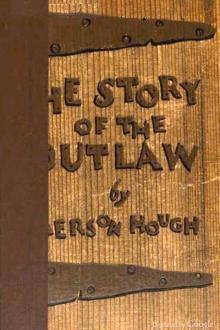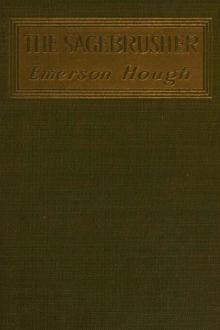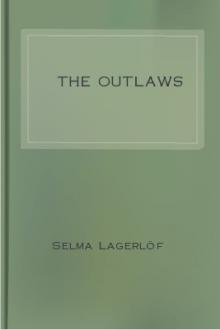The Story of the Outlaw, Emerson Hough [ereader that reads to you txt] 📗

- Author: Emerson Hough
- Performer: -
Book online «The Story of the Outlaw, Emerson Hough [ereader that reads to you txt] 📗». Author Emerson Hough
Slade's body was preserved in alcohol and kept out at the lone ranch cabin all that winter. In the spring it was sent down to Salt Lake City and buried there. As that was a prominent point on the overland trail, the tourists did the rest. The saga of Slade as a bad man was widely disseminated.
Chapter XIThe Desperado of the Plains—Lawlessness Founded on Loose Methods—The Rustlers of the Cow Country—Excuses for Their Acts—The Approach of the Commercial West.
One pronounced feature of early Western life will have been remarked in the story of the mountain settlements with which we have been concerned, and that is the transient and migratory character of the population. It is astonishing what distances were traveled by the bold men who followed the mining stampedes all over the wilderness of the upper Rockies, in spite of the unspeakable hardships of a region where travel at its best was rude, and travel at its worst well-nigh an impossibility. The West was first peopled by wanderers, nomads, even in its mountain regions, which usually attach their population to themselves and cut off the disposition to roam. This nomad nature of the adventurers made law almost an impossible thing. A town was organized and then abandoned, on the spur of necessity or rumor. Property was unstable, taxes impossible, and any corps of executive officers difficult of maintenance. Before there can be law there must be an attached population.
The lawlessness of the real West was therefore much a matter of conditions after all, rather than of morals. It proved above all things that human nature is very much akin, and that good men may go wrong when sufficiently tempted by great wealth left unguarded. The first and second decades after the close of the civil war found the great placers of the Rockies and Sierras exhausted, and quartz mines taking their place. The same period, as has been shown, marked the advent of the great cattle herds from the South upon the upper ranges of the territories beyond the Missouri river. By this time, the plains began to call to the adventurers as the mines recently had called.
Here, then, was wealth, loose, unattached, apparently almost unowned, nomad wealth, and waiting for a nomad population to share it in one way or another. Once more, the home was lacking, the permanent abode; wherefore, once more the law was also lacking, and man ruled himself after the ancient savage ways. By this time frontiersmen were well armed with repeating weapons, which now used fixed ammunition. There appeared on the plains more and better armed men than were ever known, unorganized, in any land at any period of the earth's history; and the plains took up what the mountains had begun in wild and desperate deeds.
The only property on the arid plains at that time was that of live stock. Agriculture had not come, and it was supposed could never come. The vast herds of cattle from the lower ranges, Texas and Mexico, pushed north to meet the railroads, now springing westward across the plains; but a large proportion of these cattle were used as breeding stock to furnish the upper cow range with horned population. Colorado, Wyoming, Montana, western Nebraska, the Dakotas, discovered that they could raise range cattle as well as the southern ranges, and fatten them far better; so presently thousands upon thousands of cattle were turned loose, without a fence in those thousands of miles, to exist as best they might, and guarded as best might be by a class of men as nomadic as their herds. These cattle were cheap at that time, and they made a general source of food supply much appreciated in a land but just depopulated of its buffalo. For a long time it was but a venial crime to kill a cow and eat it if one were hungry. A man's horse was sacred, but his cow was not, because there were so many cows, and they were shifting and changing about so much at best.
The ownership of these herds was widely scattered and difficult to trace. A man might live in Texas and have herds in Montana, and vice versa. His property right was known only by the brand upon the animal, his being but the tenure of a sign.
"The respect for this sign was the whole creed of the cattle trade. Without a fence, without an atom of actual control, the cattle man held his property absolutely. It mingled with the property of others, but it was never confused therewith. It wandered a hundred miles from him, and he knew not where it was, but it was surely his and sure to find him. To touch it was crime. To appropriate it meant punishment. Common necessity made common custom, common custom made common law, and common law made statutory law."[E]
The old fierro or iron mark of the Spanish cattle owner, and his venta or sale-brand to another had become common law all over the Southwest when the Anglo-Saxon first struck that region. The Saxon accepted these customs as wise and rational, and soon they were the American law all over the American plains.
The great bands of cattle ran almost free in the Southwest for many years, each carrying the brand of the owner, if the latter had ever seen it or cared to brand it. Many cattle roamed free without any brand whatever, and no one could tell who owned them. When the northern ranges opened, this question of unbranded cattle still remained, and the "maverick" industry was still held matter of sanction, there seeming to be enough for all, and the day being one of glorious freedom and plenty, the baronial day of the great and once unexhausted West.
Now the venta, or brand indicating the sale of an animal to another owner, began to complicate matters to a certain extent. A purchaser could put his own fierro brand on a cow, and that meant that he now owned it. But then some suspicious soul asked, "How shall we know whence such and such cows came, and how tell whether or not this man did not steal them outright from his neighbor's herd and put his own brand on them?" Here was the origin of the bill of sale, and also of the counter brand or "vent brand," as it is known upon the upper ranges. The owner duplicated his recorded brand upon another recorded part of the animal, and this meant his deed of conveyance, when taken together with the bill of sale over his commercial signature. Of course, several conveyances would leave the hide much scarred and hard to read; and, as there were "road brands" also used to protect the property while in transit from the South to the North or from the range to the market, the reading of the brands and the determination of ownership of the animal might be, and very often was, a nice matter, and one not always settled without argument; and argument in the West often meant bloodshed in those days. Some hard men started up in trade near the old cattle trails, and made a business of disputing brands with the trail drivers. Sometimes they made good their claims, and sometimes they did not. There were graves almost in line from Texas to Montana.
It is now perfectly easy to see what a wide and fertile field was here offered to men who did not want to observe the law. Here was property to be had without work, and property whose title could easily be called into question; whose ownership was a matter of testimony and record, to be sure, but testimony which could be erased or altered by the same means which once constituted it a record and sign. The brand was made with an iron, and it could be changed with an iron. A large and profitable industry arose in changing these brands. The rustler, brand-burner or brand-blotcher now became one of the new Western characters, and a new sort of bad-manism had its birth.
"It is very easy to see how temptation was offered to the cow thief and 'brand blotter.' Here were all these wild cattle running loose over the country. The imprint of a hot iron on a hide made the creature the property of the brander, provided no one else had branded it before. The time of priority was matter of proof. With the handy "running-iron" or straight rod, which was always attached to his saddle when he rode out, could not the cow thief erase a former brand and put over it one of his own? Could he not, for instance, change a U into an O, or a V into a diamond, or a half-circle into a circle? Could he not, moreover, kill and skin an animal and sell the beef as his own? Between him and the owner was only this little mark. Between him and changing this mark was nothing but his moral principles. The range was very wide. Hardly a figure would show on that unwinking horizon all day long. And what was a heifer here and there?"
Such was the temptation and opportunity which led many a man to step over the line between right and wrong. Their excuse lies in the fact that the line was newly drawn and that it was often vague and inexact. It was easy, from killing or rebranding an occasional cow, to see the profits of larger operation. The faithful cowboys who cared for these herds and protected them even with their lives in the interest of absent owners began in time to tire of working on a salary, and settled down into little ranches of their own, starting with a herd of cattle lawfully purchased and branded. An occasional maverick came across their range and they branded it. A brand was faint and not legible, and they put their own iron over it. They learned that pyrography with a hot poker was very profitable. The rest was easy. The first step was the one that counted; but who could tell where that first step was taken?
At any rate, cattle owners began to take notice of their cows as the prices went up, and they had laws made to protect property rapidly enhancing in value. Cow owners were required to have fixed or stencil-irons, and were forbidden to trace a pattern with a straight iron or "running-iron." Each ranch must have its own iron or stencil. Texas as early as the '60's and '70's passed laws forbidding the use of the running-iron altogether, so that after that it was not safe to be caught riding the range with a straight iron under the saddle flap. Any man so discovered had to do some quick explaining.
The next step after this was the organization of the cattle associations in the several territories and states which made the home of the cattle trade. These associations banded together in a national association. Detectives were placed at the stockyards in Chicago and Kansas City, charged with the finding of cattle stolen on the range and shipped with or without clean brands. In short, there had now grown up an armed and legal warfare between the cow men themselves—in the first place very large-handed thieves—and the rustlers and "little fellows" who were accused of being too liberal with their brand blotching. The prosecution of these men was undertaken with something of the old vigor that characterized the pursuit of horse thieves,





Comments (0)